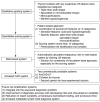Applications of machine learning and deep learning to thyroid imaging: where do we stand?
- PMID: 32660203
- PMCID: PMC7758100
- DOI: 10.14366/usg.20068
Applications of machine learning and deep learning to thyroid imaging: where do we stand?
Abstract
Ultrasonography (US) is the primary diagnostic tool used to assess the risk of malignancy and to inform decision-making regarding the use of fine-needle aspiration (FNA) and postFNA management in patients with thyroid nodules. However, since US image interpretation is operator-dependent and interobserver variability is moderate to substantial, unnecessary FNA and/or diagnostic surgery are common in practice. Artificial intelligence (AI)-based computeraided diagnosis (CAD) systems have been introduced to help with the accurate and consistent interpretation of US features, ultimately leading to a decrease in unnecessary FNA. This review provides a developmental overview of the AI-based CAD systems currently used for thyroid nodules and describes the future developmental directions of these systems for the personalized and optimized management of thyroid nodules.
Keywords: Artificial intelligence; Computer-aided diagnosis; Neoplasms; Thyroid.
Conflict of interest statement
No potential conflict of interest relevant to this article was reported.
Figures


References
-
- Haugen BR. 2015 American Thyroid Association management guidelines for adult patients with thyroid nodules and differentiated thyroid cancer: what is new and what has changed? Cancer. 2017;123:372–381. - PubMed
-
- Ha EJ, Baek JH, Na DG. Risk stratification of thyroid nodules on ultrasonography: current status and perspectives. Thyroid. 2017;27:1463–1468. - PubMed
-
- Choi SH, Kim EK, Kwak JY, Kim MJ, Son EJ. Interobserver and intraobserver variations in ultrasound assessment of thyroid nodules. Thyroid. 2010;20:167–172. - PubMed
-
- Kim HG, Kwak JY, Kim EK, Choi SH, Moon HJ. Man to man training: can it help improve the diagnostic performances and interobserver variabilities of thyroid ultrasonography in residents? Eur J Radiol. 2012;81:e352–e356. - PubMed
LinkOut - more resources
Full Text Sources
Other Literature Sources
Miscellaneous

